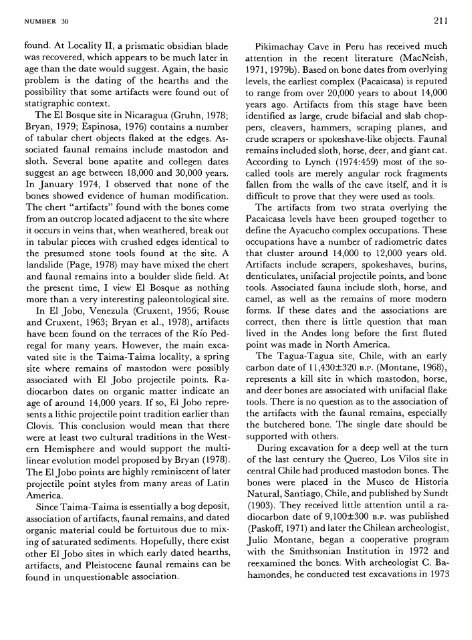Plains Indian Studies - Smithsonian Institution Libraries
Plains Indian Studies - Smithsonian Institution Libraries
Plains Indian Studies - Smithsonian Institution Libraries
Create successful ePaper yourself
Turn your PDF publications into a flip-book with our unique Google optimized e-Paper software.
NUMBER 30 211<br />
found. At Locality II, a prismatic obsidian blade<br />
was recovered, which appears to be much later in<br />
age than the date would suggest. Again, the basic<br />
problem is the dating of the hearths and the<br />
possibility that some artifacts were found out of<br />
statigraphic context.<br />
The El Bosque site in Nicaragua (Gruhn, 1978;<br />
Bryan, 1979; Espinosa, 1976) contains a number<br />
of tabular chert objects flaked at the edges. Associated<br />
faunal remains include mastodon and<br />
sloth. Several bone apatite and collegen dates<br />
suggest an age between 18,000 and 30,000 years.<br />
In January 1974, I observed that none of the<br />
bones showed evidence of human modification.<br />
The chert "artifacts" found with the bones come<br />
from an outcrop located adjacent to the site where<br />
it occurs in veins that, when weathered, break out<br />
in tabular pieces with crushed edges identical to<br />
the presumed stone tools found at the site. A<br />
landslide (Page, 1978) may have mixed the chert<br />
and faunal remains into a boulder slide field. At<br />
the present time, I view El Bosque as nothing<br />
more than a very interesting paleontological site.<br />
In El Jobo, Venezula (Cruxent, 1956; Rouse<br />
and Cruxent, 1963; Bryan et al., 1978), artifacts<br />
have been found on the terraces of the Rio Pedregal<br />
for many years. However, the main excavated<br />
site is the Taima-Taima locality, a spring<br />
site where remains of mastodon were possibly<br />
associated with El Jobo projectile points. Radiocarbon<br />
dates on organic matter indicate an<br />
age of around 14,000 years. If so, El Jobo represents<br />
a lithic projectile point tradition earlier than<br />
Clovis. This conclusion would mean that there<br />
were at least two cultural traditions in the Western<br />
Hemisphere and would support the multilinear<br />
evolution model proposed by Bryan (1978).<br />
The El Jobo points are highly reminiscent of later<br />
projectile point styles from many areas of Latin<br />
America.<br />
Since Taima-Taima is essentially a bog deposit,<br />
association of artifacts, faunal remains, and dated<br />
organic material could be fortuitous due to mixing<br />
of saturated sediments. Hopefully, there exist<br />
other El Jobo sites in which early dated hearths,<br />
artifacts, and Pleistocene faunal remains can be<br />
found in unquestionable association.<br />
Pikimachay Cave in Peru has received much<br />
attention in the recent literature (MacNeish,<br />
1971, 1979b). Based on bone dates from overlying<br />
levels, the earliest complex (Pacaicasa) is reputed<br />
to range from over 20,000 years to about 14,000<br />
years ago. Artifacts from this stage have been<br />
identified as large, crude bifacial and slab choppers,<br />
cleavers, hammers, scraping planes, and<br />
crude scrapers or spokeshave-like objects. Faunal<br />
remains included sloth, horse, deer, and giant cat.<br />
According to Lynch (1974:459) most of the socalled<br />
tools are merely angular rock fragments<br />
fallen from the walls of the cave itself, and it is<br />
difficult to prove that they were used as tools.<br />
The artifacts from two strata overlying the<br />
Pacaicasa levels have been grouped together to<br />
define the Ayacucho complex occupations. These<br />
occupations have a number of radiometric dates<br />
that cluster around 14,000 to 12,000 years old.<br />
Artifacts include scrapers, spokeshaves, burins,<br />
denticulates, unifacial projectile points, and bone<br />
tools. Associated fauna include sloth, horse, and<br />
camel, as well as the remains of more modern<br />
forms. If these dates and the associations are<br />
correct, then there is little question that man<br />
lived in the Andes long before the first fluted<br />
point was made in North America.<br />
The Tagua-Tagua site, Chile, with an early<br />
carbon date of 11,430±320 B.P. (Montane, 1968),<br />
represents a kill site in which mastodon, horse,<br />
and deer bones are associated with unifacial flake<br />
tools. There is no question as to the association of<br />
the artifacts with the faunal remains, especially<br />
the butchered bone. The single date should be<br />
supported with others.<br />
During excavation for a deep well at the turn<br />
of the last century the Quereo, Los Vilos site in<br />
central Chile had produced mastodon bones. The<br />
bones were placed in the Museo de Historia<br />
Natural, Santiago, Chile, and published by Sundt<br />
(1903). They received little attention until a radiocarbon<br />
date of 9,100±300 B.P. was published<br />
(Paskoff, 1971) and later the Chilean archeologist,<br />
Julio Montane, began a cooperative program<br />
with the <strong>Smithsonian</strong> <strong>Institution</strong> in 1972 and<br />
reexamined the bones. With archeologist C. Bahamondes,<br />
he conducted test excavations in 1973

















